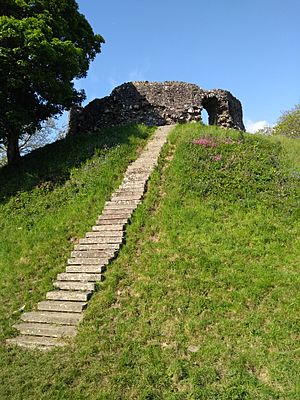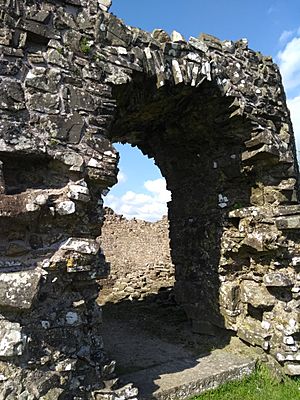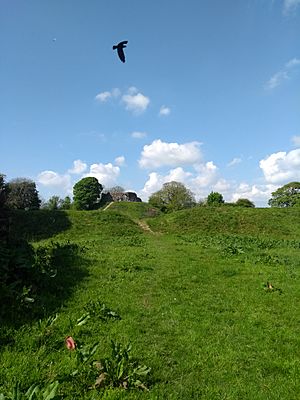Wiston Castle facts for kids
Wiston Castle (Welsh: Castell Cas-wis) is a special type of castle called a motte and bailey castle. You can find it in the village of Wiston in south west Wales. It's one of the best examples of this kind of castle in Wales!
A man named Wizo, who was a Flemish settler, started both the castle and the village. Henry I of England gave him the land after taking it from Arnulf de Montgomery. The Welsh captured Wiston Castle a few times, but it was always taken back. People stopped using the castle in the 1200s when its owner moved to Picton Castle nearby.
The castle is across from St Mary Magdalene Church. There are about 75 steps to climb up to it. Cadw looks after the castle, and it is a very important historic building, known as a Grade I listed building.
Contents
History of Wiston Castle
Early Days in Wales
Before the late 1000s, this part of Wales was called Deheubarth. It was a Welsh kingdom. King William I was the ruler of England. Rhys ap Tewdwr, the king of Deheubarth, agreed to be loyal to King William.
But when King William died in 1088, Rhys thought his agreement was over. He joined other powerful lords and attacked Worcester. This was seen as an act against the new king. In 1093, Rhys was killed in a battle while fighting Bernard de Neufmarche.
After Rhys died, the king's helpers quickly took over much of Deheubarth. Arnulf de Montgomery took the western part, including where Wiston Castle is now. Arnulf built Pembroke Castle to rule his new land.
New Rulers and Flemish Settlers
In 1102, Henry I of England became king. Arnulf de Montgomery rebelled against Henry, so Henry took Arnulf's land. This included the area around Wiston.
A few years later, in 1108, there was terrible flooding in Flanders, where Henry's mother was from. Many people lost their homes. King Henry helped them by letting them settle in his new lands in Wales. These Flemish settlers kept their own culture for a long time. You can still see their influence in the local DNA today!
Wizo Builds His Castle
The Flemish leader in the area, a man named Wizo, built a castle to control his lands. This castle was very good at protecting the area. A village grew up around the castle, and it was named after Wizo – Wiston. That's why the castle is called Wiston Castle!
Wizo shared some of his land with other Flemish people. His son, Walter fitz-Wizo, received land in 1130.
Battles and Changes
In 1147, the Welsh, led by Hywel ab Owain, captured Wiston Castle. Walter was in charge then. But the Flemish people soon got the castle back.
Later, in 1193, Hywel Sais (son of Lord Rhys) attacked the Flemish. He captured Wiston Castle and took Wizo's other son, Philip, prisoner. It took two years for the Flemish to get Wiston Castle back.
In 1220, Llywelyn Fawr attacked and damaged the castle. But William Marshall the younger ordered it to be repaired. The castle was being rebuilt with stone when it was abandoned. The original towers were made of wood. The new stone parts show how castles were built back then. The round stone wall on top of the mound is a good example of Norman stonework.
Why the Castle Was Left
The castle later belonged to Sir John Wogan. We don't know exactly how he got it. Sir John moved to Picton Castle at the end of the 1200s. After he left, Wiston Castle was abandoned.
Much later, during the English Civil War in 1643, some soldiers called Royalists set up a small camp at Wiston. They might have used the old castle mound. But they left without a fight when other soldiers, called Parliamentarians, came into the area. Soon after, a big battle happened nearby at Battle of Colby Moor, and the Royalists were defeated.
Exploring Wiston Castle Today
Wiston Castle is one of the best-preserved motte-and-bailey castles in Wales. It sits on top of a hill north of Wiston village. The motte, or mound, is about 9 meters (30 feet) high above the ditch around it.
On top of the motte, there's a round stone wall called a shell-keep. This would have been the main defense. All the buildings inside, mostly made of wood, would have been protected by this wall. The outside of the shell-keep has 18 short sides, making it look like a polygon. Some parts have fallen into the ditch.
There's an arched entrance on the south side. On either side of this arch, you can see holes where a strong wooden bar would have been used to lock the main gate. Inside the castle area, there's a large, oval bailey (a flat area) protected by a well-preserved bank. The lord's main house would have been inside this bailey.
Wiston Castle is a Grade I listed building. Cadw looks after it, and you can visit it for free all year round. There's a small car park nearby, but no other visitor facilities.
Images for kids







